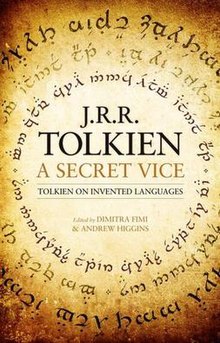A Secret Vice
 | |
| Editors | Dimitra Fimi Andrew Higgins |
|---|---|
| Author | J.R.R. Tolkien |
| Country | United Kingdom |
| Language | English |
| Subjects | Linguistics Philology Conlanging |
| Published | 07 April 2016 |
| Publisher | HarperCollins |
| Media type | Hardback, e-book |
| Pages | 300 |
| ISBN | 978-0-00-813139-5 |
| Preceded by | The Story of Kullervo |
| Followed by | The Lay of Aotrou and Itroun |
A Secret Vice is the title of a talk written by J. R. R. Tolkien in 1931, given to a literary society entitled 'A Hobby for the Home', in which he first publicly revealed his interest in invented languages. Some twenty years later, Tolkien revised the manuscript for a second presentation. It deals with constructed languages in general and the relation of a mythology to its language. He contrasts international auxiliary languages with artistic languages constructed for aesthetic pleasure. Tolkien further discusses phonaesthetics, citing Greek, Finnish and Welsh as examples of "languages which have a very characteristic and in their different ways beautiful word-form".
Content[]
Tolkien's opinion of the relation of mythology and language is reflected in examples cited in Quenya and Noldorin, the predecessors of Quenya and Sindarin. The essay contains three Quenya poems, Oilima Markirya ("The Last Ark"), Nieninque, and Earendel as well as an eight-line passage in Noldorin.[1]
A notable passage[2] from the essay comes in a context in which Tolkien relates how he randomly met a fellow language inventor in the army:[3]
The man next to me said suddenly in a dreamy voice: 'Yes, I think I shall express the accusative case by a prefix!' A memorable remark!
...Just consider the splendour of the words! 'I shall express the accusative case.' Magnificent! Not 'it is expressed', nor even the more shambling 'it is sometimes expressed', nor the grim 'you must learn how it is expressed'. What a pondering of alternatives within one's choice before the final decision in favour of the daring and unusual prefix, so personal, so attractive; the final solution of some element in a design that had hitherto proved refractory. Here were no base considerations of the 'practical', the easiest for the 'modern mind', or for the million – only a question of taste, a satisfaction of a personal pleasure, a private sense of fitness.[3]
Andrew Higgins writes that the "secret vice" was echoed in his text "Dangweth Pengolod" ("The Answer of Pengolod"), which showed Elves "practi[sing] and enjoy[ing] the same aesthetic pleasure in language invention that Tolkien did".[4]
Publication history[]
A Secret Vice was first published in The Monsters and the Critics and Other Essays (1983), together with six other essays by Tolkien, edited by his son Christopher.[5]
A new, extended critical edition was published by HarperCollins in 2016, edited by Dimitra Fimi and Andrew Higgins.[6] The new edition contains previously omitted passages from the original essay, Tolkien's drafts and notes, and a hitherto unpublished work by Tolkien, "Essay on Phonetic Symbolism".[7][8]
See also[]
References[]
- ^ Smith 2006, pp. 600–601.
- ^ Garth, John (2006). "Si Qente Feanor & Other Elvish Writings, and: Parma Eldalamberon XV". Tolkien Studies. 3 (1): 157–160.
- ^ a b Tolkien 1983, p. 199.
- ^ Higgins, Andrew (2018). "Elvish Practitioners of the 'Secret Vice'". Journal of Tolkien Research. 5 (1). Article 1.
- ^ Tolkien 1983.
- ^ Tolkien, J. R. R.; Fimi, Dimitra; Higgins, A. (2018). A Secret Vice: Tolkien on Invented Languages. HarperCollins. ISBN 978-0-00-813141-8. OCLC 975114488.
- ^ "A Secret Vice by J. R. R. Tolkien, Edited by Dimitra Fimi and Andrew Higgins - Hardcover | HarperCollins". HarperCollins UK. Retrieved 27 February 2018.
- ^ "Researching Tolkien's 'Secret Vice'". dimitrafimi.com. Retrieved 27 February 2018.
Sources[]
- Tolkien, J. R. R. (1983). "A Secret Vice". The Monsters and the Critics. pp. 198–223. ISBN 0-04-809019-0.
- Smith, Arden R. (2006). "Secret Vice, A". J. R. R. Tolkien Encyclopedia. Routledge. pp. 600–601.
External links[]
- Essays by J. R. R. Tolkien
- Constructed languages resources
- 1930 speeches